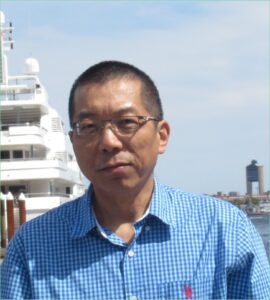Amid the staggering rise of advancements in artificial intelligence, conceptions that humans will be left behind are becoming increasingly common — but a new collaboration between City College and the AI Institute for Future Edge Networks and Distributed Intelligence at Ohio State University (OSU) aims to make use of AI to help heal people.
Dr. Jie Wei of the Computer Science department at City’s Grove School of Engineering serves as the principal investigator of the National Science Foundation-funded project that aims to use AI to help diagnose cardiovascular diseases. The standard laser sensing technologies deployed by hospitals around the country cost hundreds of thousands of dollars. Wei’s team, however, is working to develop devices with intelligent chips that harness AI computing to dramatically lower costs.

Dr. Jie Wei. Photo courtesy of Jie Wei
“The main theme of this project is that we want to work with other people to develop some very cheap sensors to do the same thing so more people can have access to these kinds of remote sensing,” Wei said. “We have some initial results suggesting that it’s possible to use just a very low budget, around one or $200 cheaper.”
CCNY and AI-EDGE’s partnership will receive up to $2.8 million throughout the course of the project, which is estimated to run through until August 2027. Wei’s team includes co-principle investigators Bingmei Fu from Grove’s Biomedical Engineering department, Nicholas Madamopoulos from Grove’s Electrical Engineering department, Jun Yoshioka from the CUNY School of Medicine at City College and Yingbin Liang, the deputy director of the AI-Edge Institute at OSU.
The project, proposed by Wei’s team and funded by the NSF in September, utilizes the concept of edge computing. This paradigm brings computation and data storage closer to the location where it’s needed — local servers and devices can be equipped with the ability to make decisions at lower latencies rather than relying on cloud-based services.
Developing remote sensors housed in smaller devices using EDGE computing can make all the difference. AI systems can potentially analyze heartbeat rhythms and blood flow to detect irregularities quickly and effectively for a fraction of the cost.
“We want to treat some cardiological disease by measuring the pulse, some dynamic of the heartbeat to identify some illness remotely,” Wei said.
Such a device would be trained by receiving multimodal data — temperature, EEG and other vital signs in addition to pulse and blood flow — from a patient with a pre-diagnosed illness. Once it can learn the intricacy of factors constituting a condition, it can better predict and decide when a patient has a problem that has yet to be diagnosed.
“That’s the whole idea — using AI machine learning to train, to learn, and to decide using those edge computing devices,” he said.
Wei got his master’s degree in computer science from the Chinese Academy of Sciences in Beijing before going on to complete his doctorate from Simon Fraser University in Burnaby, Canada in 1999. Besides his research work, he teaches undergraduate software engineering and more recently, since joining City in 1999, frequently instructs graduate-level courses in computer science with a focus on digital libraries and databases.
His research has spanned many areas — from using spectral analysis for military vehicle fingerprinting to using machine learning and AI for U.S. Air Force situational awareness. Research work using AI in healthcare has dominated many of his studies funded by the NIH.
Wei’s expertise has led to his role on the team to model the project’s AI and its capabilities for medical analysis while other team members use their engineering expertise to design the device’s hardware itself. A promising prototype constructed in the early fall semester has led them to prioritize creating a fully functioning device in the project’s first year.
“Right now we don’t see any of this kind of device available yet, so we want to be the first one to achieve this kind of thing,” he said.
After a year, Wei’s team will try side-by-side testing to ensure the chip device can simulate the standard laser sensor as closely as possible.
While the success of such a device comes with a host of possibilities for preventative care, Wei maintained that part of the project includes developing evidence-based justifications that would need to be appended to the AI’s decisions before creating diagnoses.
“Now, the trouble is that, especially for medical computing, we must provide the justifications because the doctors will make the final call,” he said. “We should explain why this is so, based on those features and suggestions made by our machine learning algorithms.”
As the project progresses, it stands poised to demonstrate how advanced AI and computing technologies can be harnessed for the greater good, and the power of collaboration between City and its partners. Wei’s journey from a math enthusiast to a pioneer in applying AI in healthcare underscores the limitless potential of combining passion with technology to create solutions that could change the world.
Judah is a senior at CUNY Baruch College, pursuing a major in journalism and minors in computer science and environmental sustainability. He is also the business editor for Baruch’s independent student newspaper, The Ticker, and co-managing editor for the Baruch Journalism Department’s magazine Dollars & Sense.